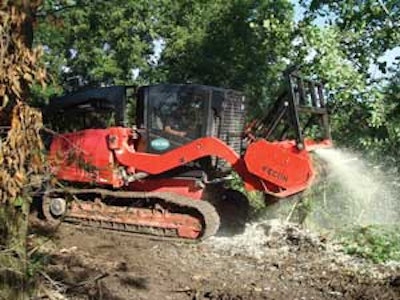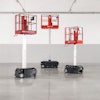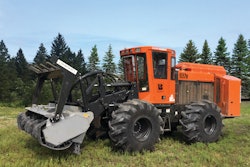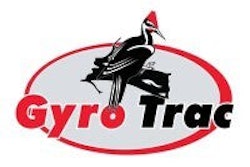
The first step in most site development projects is to clear unwanted vegetation. Depending on how often you perform this type of work and the project size, you may want to compare the benefits of mulching attachments vs. dedicated mulching machines.
Both "converted" and dedicated machines come in a variety of sizes. "For the most part, the same mulching attachment can be fitted to either," notes Tom Becker, president, Barko Hydraulics, LLC. "Mulching attachments are available from a dedicated mulching head supplier, and are sized based on the width of cut desired and the minimum hydraulic flow available to the head."
When deciding between an attachment or dedicated mulcher, you need to determine whether versatility or production is more important.
"The biggest advantage of using a skid steer or wheel loader with a cutter head attachment is the obvious benefit of versatility," says John Tucker, GyroTrac. "You can change out the cutter head for the project based on the application. If you have tasks that require multiple tools, the cutter head attachment is the way to go."
"Attachments are generally a much less expensive alternative to dedicated machines and afford you the ability to utilize your existing carrier for multiple purposes," adds Wes Hall, FAE. "Mulching attachments are an excellent way to help keep your existing fleet on the jobsite. Generally speaking, you will be looking at five to six times the cost for a dedicated prime mover vs. an attachment."
For contractors interested in expanding into land clearing, this means a much lower cost of entry. "Often, contractors in other businesses expand their business with little investment by adding a brush cutting attachment vs. buying an entirely new machine," notes Tom Hover, FTX track carrier product manager, Fecon Inc. "This helps them use equipment they already have and gives them time to develop and grow a new division of their business without purchasing an entire machine."
Dedicated to the task
Dedicated machines, on the other hand, are built from the ground up to be placed in the harshest environments, Hall points out. "The performance levels put them in a separate category when compared to typical construction or 'dirt' machines. It enables them to clear land and vegetation faster with less maintenance," he asserts.
"When working with attachments, you are forced to deal with the power supplied by the carrier," he adds. "On a dedicated application, the power plant and drive system mate together more efficiently for the size of the carrier."
You also get a carrier specifically built around the cutter head technology. "You don't just get a cutter head that comes pre-attached to a carrier," Tucker states. "You get a machine that is designed to increase the capabilities of the cutter head.
"For instance, some dedicated mulching machines have a closed-loop hydraulic system that allows for continuous pressure to the cutter head at all times," he notes. "When you cut up to a 30° slope, the cutter head doesn't lose power to the track system. On the other hand, if you use a skid steer with an attachment, you may lose cutter head pressure and, consequently, productivity."
This makes it hard to beat the performance of a dedicated machine. "In the case of the converted machines, they were designed for a different intended purpose," says Becker. The engine horsepower and pump pressures and flows are designed to efficiently manage tasks such as material handling or excavating. "Since their primary purpose was not to do land clearing, they generally do not have the installed horsepower, pressures and flows to maximize the effectiveness of the mulching head."
Production rates for a dedicated mulcher can vary with the type of material being cleared, the size, terrain and operator experience "However, given the variables, purpose-built machines can offer as much as a 100% production advantage over conventional equipment with an attachment in comparable sized machinery," says Hover.
"Skid-steer loaders with attachments are great machines to have for land clearing on an entry level, or for a finish and detail machine in a fleet of larger units," says Hover. Yet, there are limits to the size and type of work they can do as a land clearing unit.
A dedicated machine can be two to three times more productive vs. a similarly sized converted machine due to the higher hydraulic pump flow powering the mulching head, Becker points out. "Of course, to attain the higher hydraulic pump flow, more engine horsepower is also required," he notes. "Although a larger engine will consume more fuel and cost more up front, this is more than offset by the productivity gain when the contractor commits to doing land clearing full time."
Factor in utilization
The percentage of time you spend on land clearing operations can help you determine whether an attachment or a dedicated machine will be more cost effective.
"If land clearing work will be more than 50% of the schedule for a particular machine, then the original value of the machine - as a loader or excavator, for example - might be lost," says Hover. In this case, a dedicated mulcher would free up the other machine for its primary purpose. "Both can be making money at the same time. This allows for expansion of both phases of the business."
Conversely, if land clearing is less than 50% of your business, and you already own a compatible carrier such as a high-flow skid steer, excavator, wheel loader or PTO machine, you should investigate the use of an attachment. "The purpose-built, dedicated carrier with the land clearing attachment installed and designed for that carrier can cost six to seven times the price of the attachment itself, which will be more generic to fit a lot of different carriers," notes Hover.
The size of your land clearing jobs is also a factor. According to Tucker, it's hard to see productivity differences between dedicated machines and attachments on small projects of an acre or two. "It is only when you clear large plots of land and/or trees that you can truly see their performance level," he says. On a large land clearing project (4+ acres), a skid steer with an attachment would not be as productive. "The cutter head would be used for a longer period of time, allowing for more wear and tear, and your operating costs would be higher."
Calculate your O&O costs
Over the long run, a dedicated mulching machine will often hold up better than a general-purpose carrier.
"This work is typically very demanding, and a purpose-built unit will offer the longevity of service life," says Hover. "A purpose-built carrier can reduce the operating cost when repairs and maintenance are figured, due to the rugged design and the equipment, like hydraulic coolers and reversing fans, which are designed into the machines specifically for this type of work."
"[Dedicated] machines have engine cooling systems that [keep] the engine temperature within its normal operating range in a dusty environment, while working near maximum horsepower for much of the time," says Becker. "Specific safety features such as operator's cab windows designed to resist penetration by projectiles are built into dedicated land clearing machines, which may not be included on construction-type equipment. These machines also include heavy-duty air conditioning systems with added filtration to prevent dust from getting into the operator's cab."
"Conventional machines," adds Hover, "can have shorter life or higher repair costs due to the severity of the work. The secret is to properly size the machine for the work."
Of course, the bigger the machine, the higher the transportation costs. This is where smaller general-purpose machines with mulching attachments may have an advantage.
"If contractors are committed to land clearing for utility right of ways, municipal service or state or federal forest management, they need to determine how frequently the equipment will be moved from site to site and what the normal site conditions will be," says Becker. "The more a piece of equipment is to be moved, the smaller the machine should be to facilitate transporting."
Brush and small trees can typically be handled with 200-hp machines, while 300- to 500-hp machines are best suited for larger trees. "Generally, the 200-hp and smaller machines provide the easiest transport and have more attachment options available," says Becker.
Of course, there is more to selection than horsepower. "Many people fall for the horsepower trap," says Tucker. He advises looking for consistent pressure to the cutter head, as well. "The cutter head can only cut as fast as the hydraulic system that pushes the head allows. More horsepower doesn't necessarily mean more productivity. It does, however, contribute to more weight, machine costs and fuel consumption."
In the end, you need to look at the options and weigh all the costs to determine the most productive and cost-effective solution.
"Attachments are an excellent choice for someone getting started in the mulching aspect of land clearing, as it is a better route to get acclimated," Hall comments. But dedicated machines may offer the greater long-term payback. "The initial cost of the dedicated machine is often a shock to most contractors, but their increased productivity and lower maintenance costs in the long run pay for themselves over time."




















